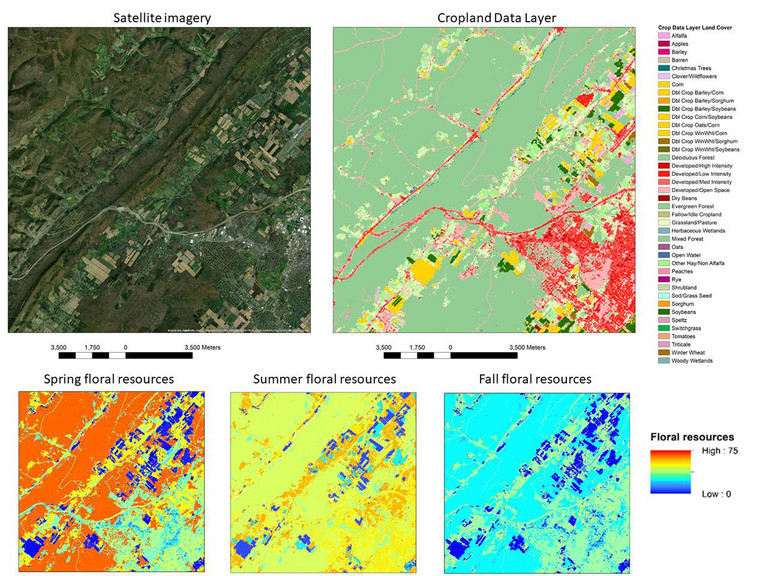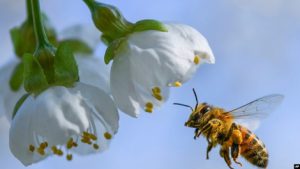Images from the “methodology” page on Beescape.org.
UNIVERSITY PARK, Pa. — A new online tool and community, called Beescape, enables beekeepers, or anyone interested in bees, to understand the specific stressors to which the bees in their managed hives, home gardens or farms are exposed, according to researchers at Penn State.
“Pollinators, particularly bees, play a vital role in supporting ecosystems in agricultural, urban and natural landscapes,” said Christina Grozinger, distinguished professor of entomology and director of the Center for Pollinator Research in Penn State’s College of Agricultural Sciences. “Nearly 90 percent of flowering plant species use pollinators to set seed and fruit, which animals — including humans — rely on for food.”
Yet Pennsylvania beekeepers lose nearly 50 percent of their honey bee colonies each winter, Grozinger added, and several wild bee species — including the bumble bee Bombus pensylvanicus — are threatened or endangered. These trends are occurring across the United States and around the world.
“We know that bee populations are declining because of several key stressors, including exposure to insecticides, reduced abundance and diversity of the flowering plants that bees depend on for their food, and loss of nesting habitat for wild bees,” she said.
Grozinger noted that bees travel large distances — several kilometers from their hives in the case of honey bees — to find food for their babies. But it has been nearly impossible for a beekeeper, or anyone interested in understanding what the bees in their backyards or farms are experiencing, to know what stressors their bees might encounter during their trips.
Grozinger and her colleagues designed Beescape.org to answer these questions. Previous work by members of the research team created methods to estimate the forage quality, nesting habitat quality and insecticide load in a landscape.
Beescape.org allows users to select a specific location — the apiary where they house their honey bee colonies, their home garden or their farm, for example — and obtain these landscape-quality scores for the surrounding region, up to 5 kilometers away. Users also can examine the crops that are being grown in the areas around them.
“Beescape allows people to see the world as a bee, which will help them make decisions about where to place their colonies or steps they and their neighbors can take, such as planting pollinator gardens or reducing insecticide use, to make the landscape more friendly for bees,” said project collaborator Maggie Douglas, an assistant professor at Dickinson College in Carlisle.
Importantly, noted Grozinger, Beescape enables researchers to partner with beekeepers and gardeners to gather information about how their bees are doing. The data generated from this partnership and community of collaborators will help researchers to better calculate how these landscape-quality scores translate to health outcomes for bees.
“With data provided by beekeepers from agricultural, rural and urban landscapes across multiple states, we will be able to develop high-quality predictive models that will be included in the website in the future,” said Melanie Kammerer Allen, graduate student in ecology at Penn State, who is involved in the project. “This will allow beekeepers to determine if they should provide the bees with supplementary food, for example, or for a grower to decide if they should add pollinator nesting habitat near their crops.”
The team collaborated with Azavea, a Philadelphia-based company that designs civic geospatial software and data analytics for the web, to develop the site.
The site currently has map information for Pennsylvania, Indiana and Illinois, and the team plans to include additional states in the future. Beekeepers and individuals with wild bee hotels in their backyards are encouraged to join the Beescape.org community and help provide information on the health of their bees.
Beescape is a partnership led by Penn State’s College of Agricultural Sciences, Center for Pollinator Research and Huck Institutes of the Life Sciences. Other collaborators include Eric Lonsdorf, a lead scientist at the University of Minnesota’s Institute on the Environment; Harland Patch, research scientist; Doug Sponsler, postdoctoral fellow; and Kate Anton, research technician, all with the Penn State Department of Entomology; Adam Dolezal, assistant professor at the University of Illinois, Urbana-Champaign; and Brock Harpur, assistant professor at Purdue University.
The research was supported by funding from the U.S. Department of Agriculture’s National Institute of Food and Agriculture, the Foundation for Food and Agricultural Research, and the National Socio-Environmental Synthesis Center.
To learn more, visit Beescape.org or Penn State’s Center for Pollinator Research at https://ento.psu.edu/pollinators.







